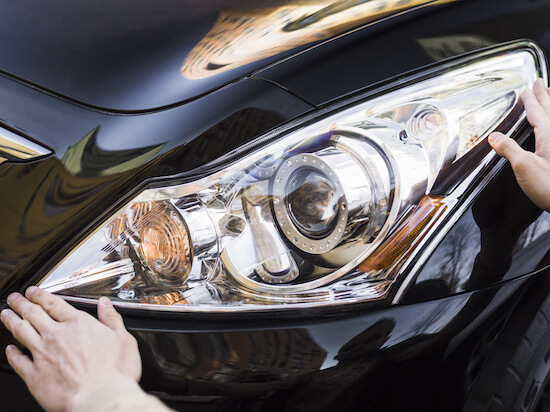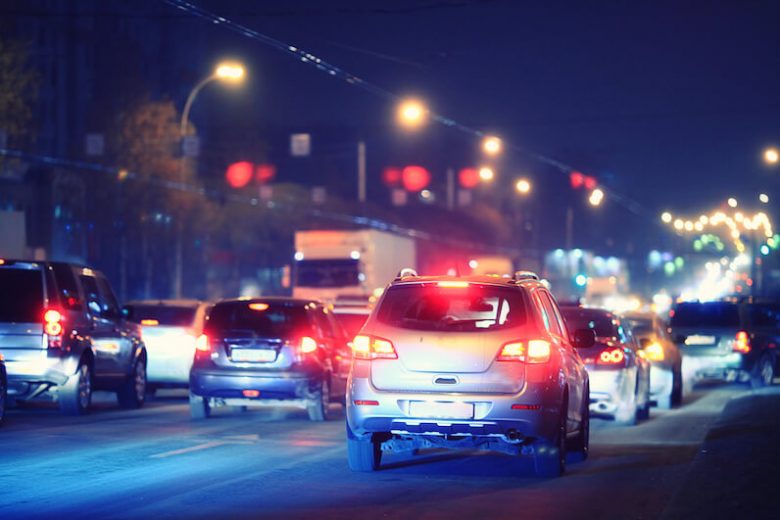What comes to mind when you think about the nighttime? Maybe it’s shooting stars, your warm bed, or even a night out with coworkers. Do car accidents come to mind? If not, they should.
Use eTags© to Quickly Complete Your DMV Service. Renewals, Title Transfers and More, All Online!
Data from the National Safety Council (NSC) suggests you’re most likely to get in a fatal car accident on a Saturday night. NSC also shows that drivers run the highest risk of a non-fatal crash on Fridays from 4 PM – 7:59 PM. Nights become longer as winter approaches, making it crucial to know how to drive safely when it gets dark outside.
What makes driving at night so dangerous
Every March Americans set their clocks an hour forward because of Daylight Saving Time. In November, they set clocks back an hour. This means that we have more light during the morning and less light as the day becomes night. Unless you’re a cat, less light makes it more difficult to see.
Older headlights produce 80% less light on average from when they’re first installed

Impaired vision and low visibility is partly to blame
Low visibility is a big reason why it’s more dangerous to drive at night. Normal headlights only help up to 250 feet at night. This doesn’t account for the fact that older headlights produce 80% less light on average. What’s more, is that many American drivers are visually impaired. The American Foundation for the Blind states that around 13% of American adults have trouble seeing. Just because you have trouble seeing doesn’t mean that your license gets revoked. Also, what “trouble seeing” means varies per state.
14 out of 50 states don’t test people’s peripheral vision when they apply for a driver’s license
The American Academy of Ophthalmology reports 14 out of 50 states don’t even test a driver’s peripheral vision when it’s time to get a driver’s license. While this may not be as much as a problem in cities with well-lit streets, vision-impaired individuals in rural areas might be in more danger if they drive at night. Factors like these (plus the fact that it’s just harder to see when it’s dark out) shed light on why nighttime accidents jumped 11% from 2019 to 2020.

Watch out for senior and teenage drivers on your next night drive
Certain age groups’ nighttime habits can also make it more dangerous to drive when it gets dark out. A 2021 study examined drivers who were 65 or older. Older drivers with visual impairments had an estimated 52-foot longer stopping distance time after seeing a hazard. In real life, seniors with vision problems might not realize there’s an obstacle in the road until it’s too late. The CDC also found that most vision-related problems are due to getting older.
33% of all teenage vehicle-related deaths in 2019 happened from the hours of 6 PM – 12 AM
Driving at night is more dangerous for older people and for those driving by them. Alternatively, the Children’s Hospital of Philadelphia found teens are more likely to get in serious car crashes at night. Also, they note that 33% of all vehicle accidents resulting in teen deaths happened from 6 PM – 12 AM in 2019. An inexperienced driver can be just as dangerous as a senior driver.

How to drive safely at night
Our brains are quite different from our ancestors from thousands of years ago. One thing hasn’t changed: nighttime signals sleep to the brain and body. Unsurprisingly, driving at night can make you feel drowsy or fatigued. People who work at night, like truck drivers and bartenders, may be especially at risk because of our natural sleep cycle and that they work long shifts. NHTSA states that a large chunk of crashes occur between 12 AM – 6 AM because of drowsy drivers.
To drive safely at night:
• Wear anti-reflective glasses at night if you need them
• Get a full night of sleep and don’t drive if you haven’t
• Get a routine eye exam at your local optometrist every year
• Look away and to the right of your car if you’re blinded by an oncoming car’s high beams
• Avoid driving under the influence at all costs—even if that means leaving
your car and picking it up the next day
• Don’t drive when there’s bad weather (especially important with hurricane season or when it snows)
•Make sure your headlights work properly (align them correctly, polish them
and consider replacing them after 3 years)
• Have your registration and insurance information within reach (like in your glove box)

You don’t need to be scared the next time you drive your registered vehicle at night. Just be mindful. Watch your speed, stay focused, and stay off your cellphone. Stay safe out there!
